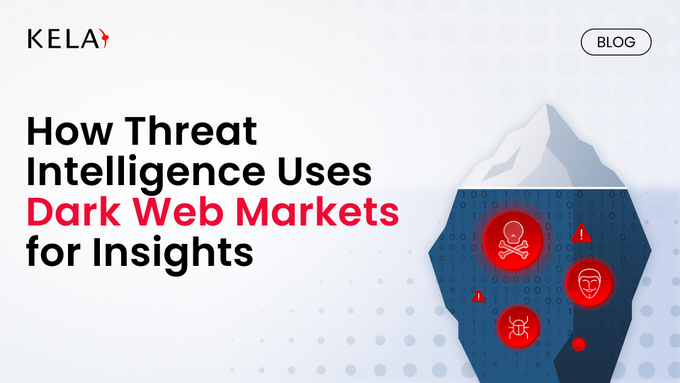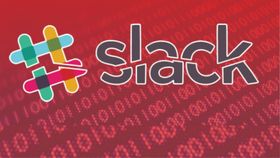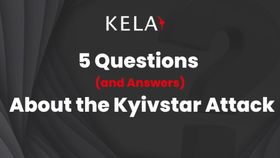How Threat Intelligence Uses Dark Web Markets for Insights
Dark web markets are hidden hubs where stolen data and hacking tools are sold. Monitoring these markets helps organizations detect breaches early and stop attacks.
Published August 25, 2025

Cyber threats are constantly changing, so organizations must find hidden risks before attacks occur. Many cybercriminal activities happen in secret online spaces where stolen data and hacking tools are bought and sold. Knowing what happens in these hidden places helps your security team spot threats early and build stronger defenses.
In this blog, we will explore what is a dark web market and how threat intelligence uses insights from these markets to protect your organization from cyber attacks.
» Skip to the solution: Try KELA's cyber threat intelligence for free
What Is a Dark Web Market?
Dark web markets are hidden online marketplaces where cybercriminals trade stolen data, hacking tools, and illegal services.
Accessible only through specialized networks that ensure anonymity, these markets are a major source of threat intelligence. Monitoring them gives organizations early insight into breaches, emerging attack methods, and the tactics used by cybercriminals.
What Is Threat Intelligence?
Threat intelligence is the collection, analysis, and sharing of information about potential cyber threats. It helps organizations understand risks before they turn into active attacks.
By studying cybercriminal activities, especially on hidden platforms like the dark web, security teams can predict attacks, improve defenses, and respond faster to incidents.
» Learn more: The role of a threat intelligence analyst
Benefits of Threat Intelligence from Dark Web Markets
- Uncovers hidden risks: Monitoring dark web markets reveals stolen data and attack plans before they reach your organization, helping you identify threats that might otherwise go unnoticed.
- Exposes attacker tactics: Understanding the tools, techniques, and behaviors shared by cybercriminals on these markets gives your security team a clearer picture of how attacks happen.
- Supports smarter decisions: Executives and security leaders gain actionable insights from threat intelligence that guide better investment in security measures and risk reduction efforts.
- Shifts from reactive to proactive: Access to real-time intelligence from dark web activity enables your organization to anticipate threats and take steps to prevent attacks instead of responding after damage occurs.
- Informs strategic security planning: Analyzing long-term trends in dark web activity allows organizations to prioritize security investments and align their defense strategies with evolving threats.
» Not convinced? Here are more reasons you need cyber threat intelligence
Who Benefits From Threat Intelligence?
Threat intelligence offers valuable insights that help organizations better understand cyber threats, respond faster to incidents, and anticipate future risks. Different types of organizations and roles benefit in unique ways:
- Small and Medium-Sized Businesses (SMBs): SMBs usually have limited cybersecurity resources. Threat intelligence gives them affordable access to expert-level insights. This helps to prioritize security efforts and reduce any risks they might otherwise miss.
- Large enterprises: Enterprises with dedicated security teams use threat intelligence to improve efficiency, reduce incident response costs, and enhance analysts’ ability to detect and handle threats by integrating external threat data into their processes.
» Read more: Inside the threat intelligence market
3 Types of Threat Intelligence
Threat intelligence is not a single process but a layered approach that serves different purposes within a cybersecurity framework. Each type provides unique insights, from detecting immediate threats to guiding long-term security strategies.
1. Tactical Threat Intelligence
Tactical threat intelligence focuses on immediate threats and short-term indicators of compromise (IOCs), such as malicious IP addresses, domain names, and file hashes. It is usually automated and integrated into security tools through data feeds.
While useful for blocking attacks quickly, tactical intelligence has a short lifespan because attackers frequently change infrastructure. It is best used for rapid detection but should be combined with deeper analysis for better context.
2. Operational Threat Intelligence
Operational threat intelligence provides context about active or planned cyber campaigns. It answers key questions: who is attacking, why they are targeting a specific organization, and how they are carrying out attacks.
This level of intelligence tracks the tactics, techniques, and procedures (TTPs) of threat actors, making it valuable for predicting their next moves. Unlike tactical intelligence, it relies heavily on human analysis and has a longer lifespan because TTPs change less frequently.
3. Strategic Threat Intelligence
Strategic threat intelligence takes a high-level view of cyber risks. It connects cyber threats to global events, economic conditions, and industry-specific risks. Executives and decision-makers use this intelligence to guide cybersecurity investments and long-term security strategies.
It is the most resource-intensive type, and it requires expertise in both cybersecurity and geopolitics. Reports generated from strategic intelligence help organizations align security priorities with business goals.
» Make sure you know the differences between vulnerabilities vs. threats vs. risks
Core Sources of Threat Intelligence
- Internal telemetry: Internal telemetry includes logs, network traffic, and endpoint monitoring data from within an organization. It provides reliable, organization-specific insights into suspicious activities but does not show what attackers are planning externally.
- External data feeds: External data feeds aggregate information from cybersecurity vendors, research organizations, and government agencies. These feeds provide broad visibility into attack trends but may contain generalized information that requires filtering to ensure relevance.
- Dark web sources: Dark web sources, including dark web markets, forums, and private messaging platforms, provide early insight into stolen data sales, planned attacks, and the tools cybercriminals are developing. While highly valuable, these sources can be difficult to access and often require specialized monitoring tools to separate real threats from scams.
» Find out if darknet markets are going out of business, and what will happen next
How Threat Intelligence Extracts and Applies Insights From Dark Web Markets
Threat intelligence relies heavily on dark web monitoring to uncover stolen data, track emerging attack tools, and understand cybercriminal behavior. By analyzing these underground activities, organizations can detect breaches early, strengthen defenses, and anticipate future attacks.
Compromised Data in Dark Web Markets
Dark web markets are major trading hubs for stolen information and illegal services. Monitoring these marketplaces gives organizations early warnings about data breaches and potential account takeovers. The most commonly found data includes:
- Login credentials: Usernames and passwords for personal, corporate, or financial accounts.
- Unauthorized account access: Active session tokens or compromised logged-in accounts.
- Hacked corporate and private accounts: Email, cloud, and business application access.
- Personally identifiable information (PII): ID numbers, addresses, and phone numbers.
- Financial records: Credit card details and bank account information
Tracking this information allows security teams to prioritize patching, enforce stronger authentication measures, and alert affected users before attackers exploit the data.
» Here are the most targeted entry points by hackers
Early Warning of Malware and Exploit Discussions
Dark web forums and marketplaces often reveal new malware variants, exploit kits, and ransomware strains before they are used in active attacks. Cybercriminals share proof-of-concept exploits, discuss vulnerabilities, and even leak information ahead of public disclosure.
By monitoring these conversations, security teams can:
- Gather malware hashes and indicators of compromise for faster detection.
- Identify which vulnerabilities are being targeted most actively.
- Update defenses and patch systems before large-scale campaigns begin.
Did you know? KELA’s platform delivers real-time intelligence on real threats so you can act fast and stop attacks before they happen.
» See our complete guide to combating ransomware
Profiling Threat Actors to Anticipate Campaigns
Dark web surveillance also provides insight into the attackers themselves. Analysts can profile threat actors by tracking their aliases, communication patterns, and language use. This helps:
- Link underground profiles to specific cybercriminal groups
- Identify the TTPs used in recent attacks.
- Detect attacks-for-hire or insider data sales that indicate upcoming campaigns.
This level of profiling allows organizations to attribute attacks more accurately and predict future campaigns, which helps to improve how they allocate resources and respond to threats.
» Make sure you understand how threat actors breach and exploit your data
Using Dark Web Trends for Strategic Security Planning
Long-term security strategies also benefit from analyzing dark web market trends. Rising demand for specific exploit types, malware tools, or proof-of-concept codes shows which vulnerabilities attackers are most interested in targeting.
By tracking these trends, organizations can:
- Prioritize investment in defensive technologies.
- Focus threat-hunting initiatives on the most likely attack vectors.
- Align strategic security planning with evolving cybercriminal tactics.
Did you know? KELA's platform recorded a 200% increase in mentions of malicious AI tools in 2024, highlighting a growing underground market for AI-assisted cybercrime. This shows how crucial AI-powered monitoring tools and real-time alerts are in identifying these trends
» Concerned about the future? See these other trends shaping the future of CTI, or check out our future of cybercrime podcast
How KELA Cyber Strengthens Your Threat Intelligence Beyond Dark Web Markets
Dark web markets offer important information on stolen data, attack tools, and cybercriminal behavior. However, these markets cover only a portion of the cyber threat landscape. Many threats emerge from less visible areas like the deep web, private forums, and offline networks, which traditional monitoring often misses.
At KELA Cyber, we expand monitoring to these hard-to-reach sources. Using advanced AI technology and comprehensive data analysis, we provide your organization with timely and actionable insights. This allows you to move beyond reacting to attacks and instead anticipate and prevent threats before they happen.
» Ready to get started? Contact us to learn more about our cyber threat intelligence services
FAQs: Dark Web Markets and Cybersecurity Insights
What is a dark web market?
A dark web market is an online platform where cybercriminals trade stolen data, hacking tools, and illegal services. These hidden marketplaces provide valuable information for threat intelligence, helping organizations detect and respond to emerging cyber threats early.
How does threat intelligence monitor dark web markets?
Threat intelligence uses advanced tools like AI-driven data collection, dark web search engines, and automated monitoring to scan dark web markets. This continuous monitoring uncovers stolen credentials, malware discussions, and attacker behavior.
What types of data are commonly found in dark web markets?
Common compromised data includes login credentials, unauthorized account access, personal identity records, financial information, and hacked corporate accounts.
How can insights from dark web markets improve my organization’s cybersecurity?
Insights from dark web markets reveal attacker tactics, emerging malware, and compromised assets. This allows your security team to prioritize patches, strengthen defenses, anticipate attacks, and respond more effectively to cyber threats.





